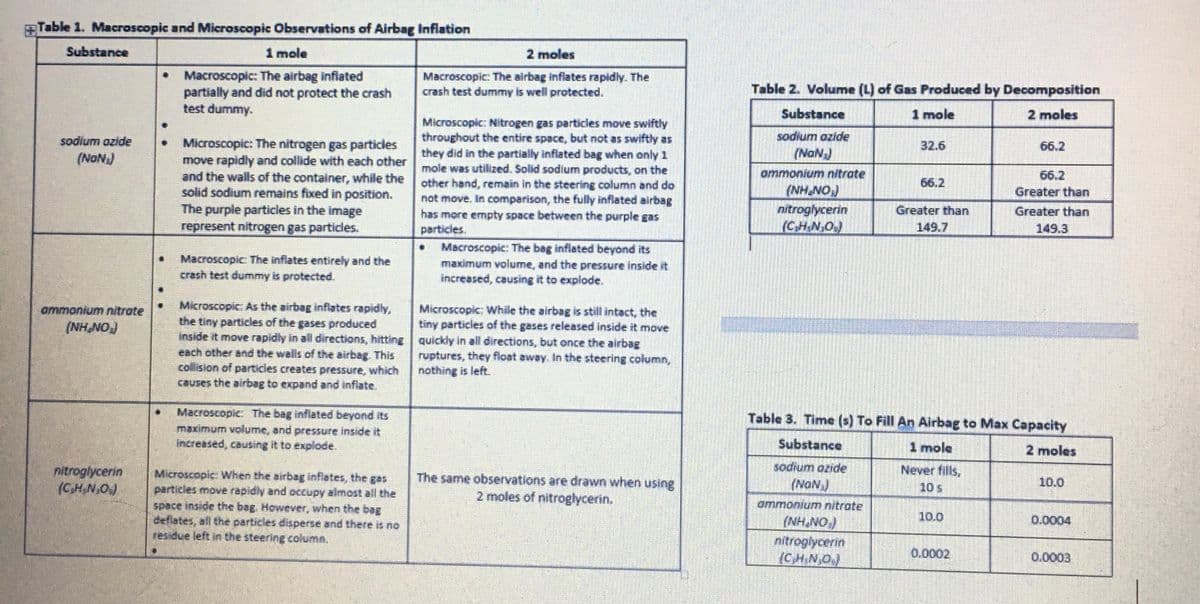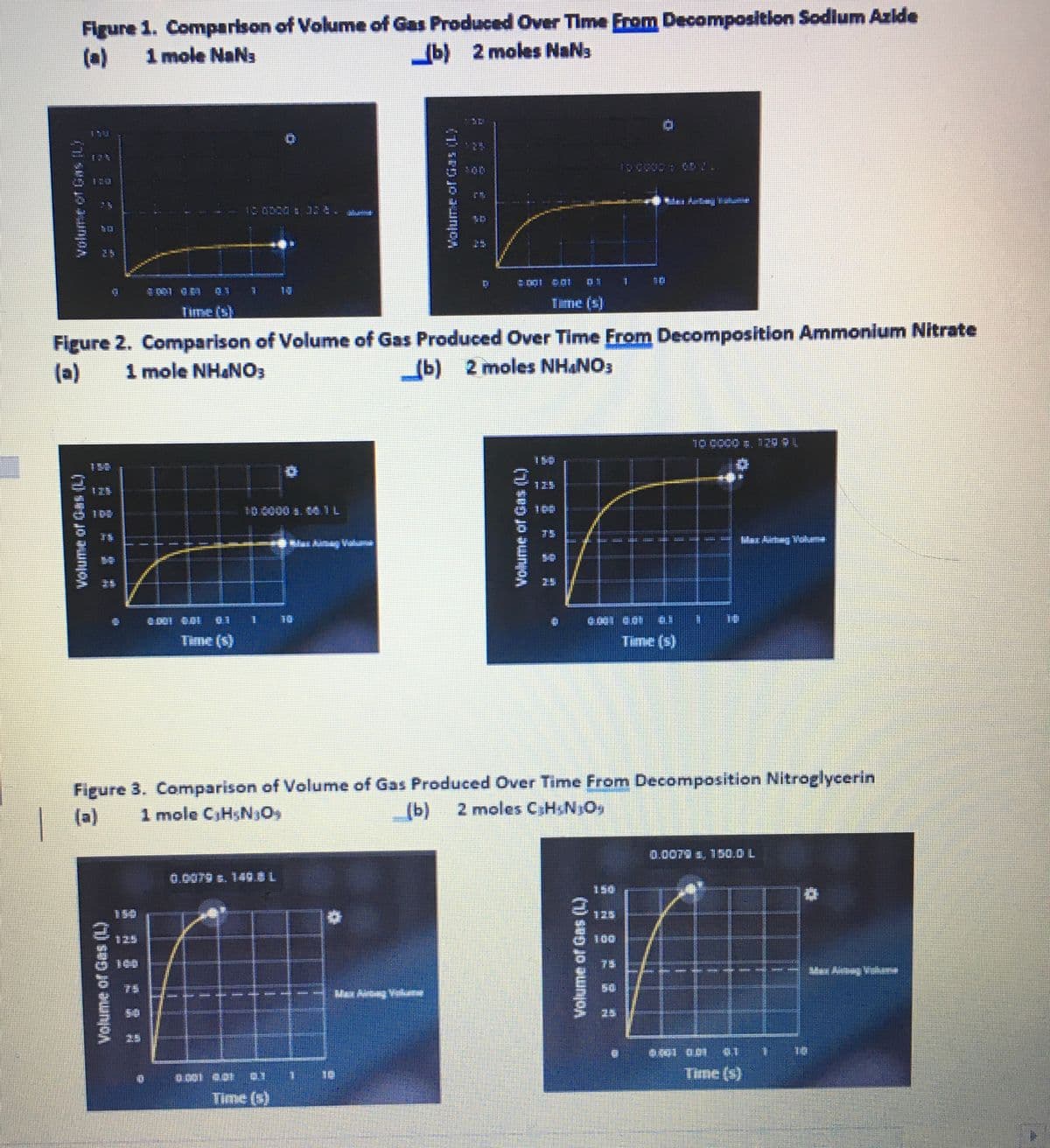Scientific question: how does the choice of chemical ingredient in a airbag influence its effectiveness. Point directly to the collected data as evidence. Since the scientific question relates the chemical ingredients to effectiveness, you might consider discussing all the outcomes for each chemical ingredient shown in the image attached. (time, volume, popped/not inflated, enough/inflated perfectly, amount initially used)) discuss all of this separately. Include which chemical or chemicals worked the best.
Scientific question: how does the choice of chemical ingredient in a airbag influence its effectiveness. Point directly to the collected data as evidence. Since the scientific question relates the chemical ingredients to effectiveness, you might consider discussing all the outcomes for each chemical ingredient shown in the image attached. (time, volume, popped/not inflated, enough/inflated perfectly, amount initially used)) discuss all of this separately. Include which chemical or chemicals worked the best.
Introductory Chemistry: A Foundation
8th Edition
ISBN:9781285199030
Author:Steven S. Zumdahl, Donald J. DeCoste
Publisher:Steven S. Zumdahl, Donald J. DeCoste
Chapter1: Chemistry: An Introduction
Section: Chapter Questions
Problem 11ALQ
Related questions
Question
100%
Scientific question: how does the choice of chemical ingredient in a airbag influence its effectiveness.
Point directly to the collected data as evidence. Since the scientific question relates the chemical ingredients to effectiveness, you might consider discussing all the outcomes for each chemical ingredient shown in the image attached. (time, volume, popped/not inflated, enough/inflated perfectly, amount initially used)) discuss all of this separately. Include which chemical or chemicals worked the best.

Transcribed Image Text:+Table 1. Macroscopic and Microscopic Observations of Airbag Inflation
Substance
sodium ozide
(NON)
ammonium nitrate
(NH.NO)
nitroglycerin
(C₂H₂N₂O)
€1
1 mole
Macroscopic: The airbag inflated
partially and did not protect the crash
test dummy.
Microscopic: Nitrogen gas particles move swiftly
throughout the entire space, but not as swiftly as
Microscopic: The nitrogen gas particles
move rapidly and collide with each other they did in the partially inflated bag when only 1
and the walls of the container, while the
solid sodium remains fixed in position.
The purple particles in the image
represent nitrogen gas particles.
mole was utilized. Solid sodium products, on the
other hand, remain in the steering column and do
not move. In comparison, the fully inflated airbag
has more empty space between the purple gas
particles.
Macroscopic: The inflates entirely and the
crash test dummy is protected.
Microscopic: As the airbag inflates rapidly,
the tiny particles of the gases produced
inside it move rapidly in all directions, hitting
each other and the walls of the airbag. This
collision of particles creates pressure, which
causes the airbag to expand and inflate.
Macroscopic: The bag inflated beyond its
maximum volume, and pressure inside it
increased, causing it to explode.
2 moles
Macroscopic: The airbag inflates rapidly. The
crash test dummy is well protected.
Microscopic: When the airbag inflates, the gas
particles move rapidly and occupy almost all the
space inside the bag. However, when the bag
deflates, all the particles disperse and there is no
residue left in the steering column.
Macroscopic: The bag inflated beyond its
maximum volume, and the pressure inside it
increased, causing it to explode.
Microscopic: While the airbag is still intact, the
tiny particles of the gases released inside it move
quickly in all directions, but once the airbag
ruptures, they float away. In the steering column,
nothing is left.
The same observations are drawn when using
2 moles of nitroglycerin.
Table 2. Volume (L) of Gas Produced by Decomposition
Substance
1 mole
2 moles
sodium ozide
(NGN)
ammonium nitrate
YNH.NOJ
nitroglycerin
(C₂H₂N₂O)
Greater than
ammonium nitrate
(NH, NO
nitroglycerin
(CH.NO
Table 3. Time (s) To Fill An Airbag to Max Capacity
Substance
1 mole
2 moles
sodium ozide
(NON)
Never fills,
105
10.0
66.2
0.0002
Greater than
Greater than
10.0
0.0003

Transcribed Image Text:Figure 1. Comparison of Volume of Gas Produced Over Time From Decomposition Sodium Azide
(b) 2 moles NaN3
(-)
1 mole NaNs
Figure 2. Comparison of Volume of Gas Produced Over Time From Decomposition Ammonium Nitrate
1 mole NH.NO3
(b) 2 moles NH4NO3
Time (s)
Figure 3. Comparison of Volume of Gas Produced Over Time From Decomposition Nitroglycerin
1 mole C₂H5N₂O+
(b) 2 moles C H&NO
(7) seg jo awnjJOA
0.0079 s. 140.BL
1
401 49 41
Time (s)
Wan Abong Vaskem
(se jo njOJA.
Time (s)
1
Man Armag ficken
Expert Solution
This question has been solved!
Explore an expertly crafted, step-by-step solution for a thorough understanding of key concepts.
This is a popular solution!
Trending now
This is a popular solution!
Step by step
Solved in 3 steps

Knowledge Booster
Learn more about
Need a deep-dive on the concept behind this application? Look no further. Learn more about this topic, chemistry and related others by exploring similar questions and additional content below.Recommended textbooks for you

Introductory Chemistry: A Foundation
Chemistry
ISBN:
9781285199030
Author:
Steven S. Zumdahl, Donald J. DeCoste
Publisher:
Cengage Learning

Chemistry for Engineering Students
Chemistry
ISBN:
9781285199023
Author:
Lawrence S. Brown, Tom Holme
Publisher:
Cengage Learning

Chemistry: Principles and Reactions
Chemistry
ISBN:
9781305079373
Author:
William L. Masterton, Cecile N. Hurley
Publisher:
Cengage Learning

Introductory Chemistry: A Foundation
Chemistry
ISBN:
9781285199030
Author:
Steven S. Zumdahl, Donald J. DeCoste
Publisher:
Cengage Learning

Chemistry for Engineering Students
Chemistry
ISBN:
9781285199023
Author:
Lawrence S. Brown, Tom Holme
Publisher:
Cengage Learning

Chemistry: Principles and Reactions
Chemistry
ISBN:
9781305079373
Author:
William L. Masterton, Cecile N. Hurley
Publisher:
Cengage Learning

Chemistry by OpenStax (2015-05-04)
Chemistry
ISBN:
9781938168390
Author:
Klaus Theopold, Richard H Langley, Paul Flowers, William R. Robinson, Mark Blaser
Publisher:
OpenStax

Introductory Chemistry: An Active Learning Approa…
Chemistry
ISBN:
9781305079250
Author:
Mark S. Cracolice, Ed Peters
Publisher:
Cengage Learning

Principles of Modern Chemistry
Chemistry
ISBN:
9781305079113
Author:
David W. Oxtoby, H. Pat Gillis, Laurie J. Butler
Publisher:
Cengage Learning